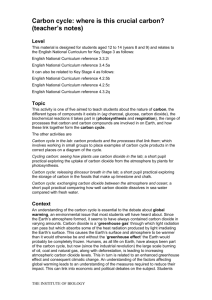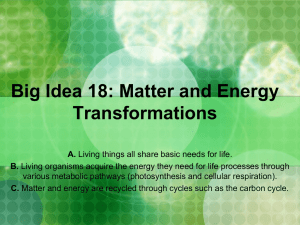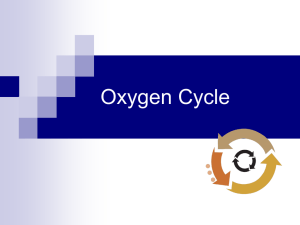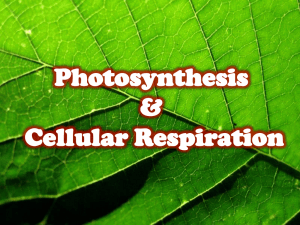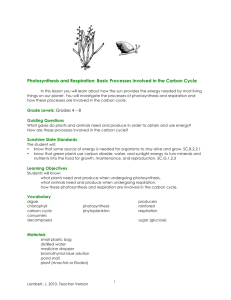Photosynthesis and Respiration: What Gases Are Exchanged
advertisement
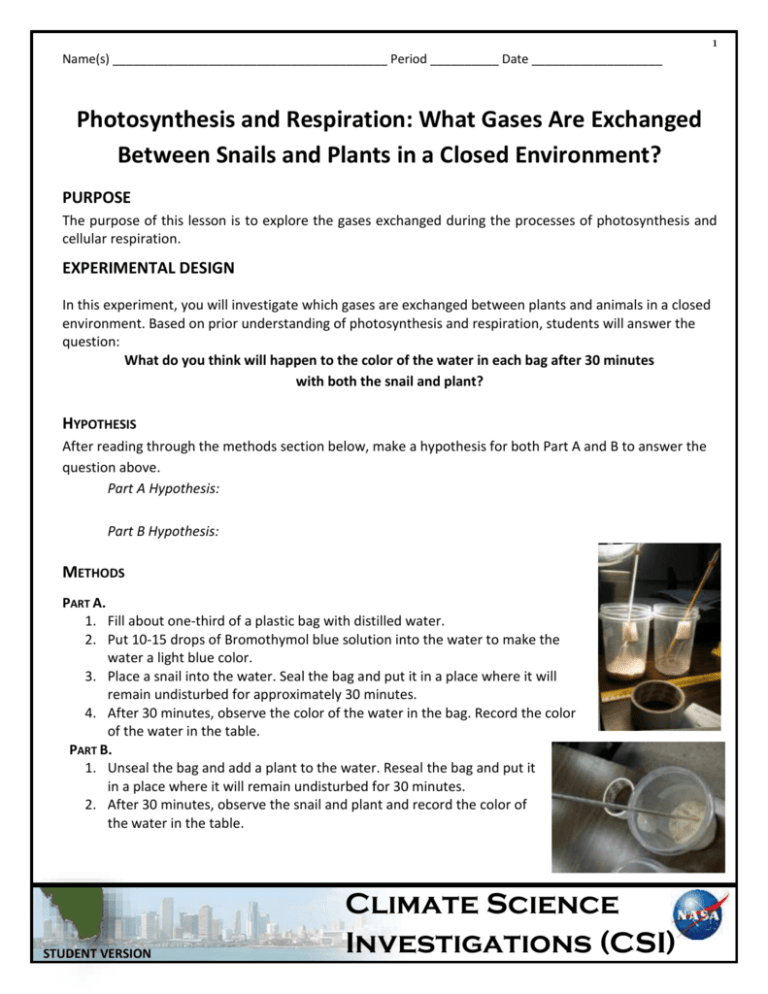
1 Name(s) ________________________________________ Period __________ Date ___________________ Photosynthesis and Respiration: What Gases Are Exchanged Between Snails and Plants in a Closed Environment? PURPOSE The purpose of this lesson is to explore the gases exchanged during the processes of photosynthesis and cellular respiration. EXPERIMENTAL DESIGN In this experiment, you will investigate which gases are exchanged between plants and animals in a closed environment. Based on prior understanding of photosynthesis and respiration, students will answer the question: What do you think will happen to the color of the water in each bag after 30 minutes with both the snail and plant? HYPOTHESIS After reading through the methods section below, make a hypothesis for both Part A and B to answer the question above. Part A Hypothesis: Part B Hypothesis: METHODS PART A. 1. Fill about one-third of a plastic bag with distilled water. 2. Put 10-15 drops of Bromothymol blue solution into the water to make the water a light blue color. 3. Place a snail into the water. Seal the bag and put it in a place where it will remain undisturbed for approximately 30 minutes. 4. After 30 minutes, observe the color of the water in the bag. Record the color of the water in the table. PART B. 1. Unseal the bag and add a plant to the water. Reseal the bag and put it in a place where it will remain undisturbed for 30 minutes. 2. After 30 minutes, observe the snail and plant and record the color of the water in the table. STUDENT VERSION Climate Science Investigations (CSI) 2 Name(s) ________________________________________ Period __________ Date ___________________ RESULTS: Table. Color, Presence of CO2, and Processes Organisms in Environment Color of water after 30 minutes Is carbon dioxide present? What processes are going on? Snail Snail and plant FINDINGS Write a summary of your results. CONCLUSIONS: DEVELOPING EXPLANATIONS FROM EVIDENCE 1. When an animal respires, what gas is released or given off? 2. Why did the water change color with the snail? 3. After a plant is placed in the environment with the snail, what happens to the color of the water in the bag in the light? Explain. 4. Many trees in the rainforest are being destroyed for farming and ranching. Based on what you have learned in this investigation, explain how the disappearance of the rainforest could affect the type and amount of gases in the environment. STUDENT VERSION Climate Science Investigations (CSI) 3 Name(s) ________________________________________ Period __________ Date ___________________ 5. Phytoplankton are photosynthetic algae in the oceans. What gas do these organisms use? What gas do these organisms produce? 6. Using the CSI Causes of Climate Change Module and the Windows 2 Universe Carbon Cycle Game Web links listed below, investigate the carbon cycle. Use a blank sheet of paper to draw and label a diagram and include the processes of photosynthesis and respiration. Then fill in the table below to summarize the carbon cycle. CSI: Causes of Climate Change Module – The Carbon Dioxide Story http://www.ces.fau.edu/nasa/module-4/causes/carbon_story.php The Carbon Cycle Game http://www.windows.ucar.edu/earth/climate/carbon_cycle.html Fill in the table to summarize your drawing. Which processes increases carbon dioxide in the atmosphere? STUDENT VERSION Is the process mainly natural, humancaused, or both? Give an example. Which processes decrease carbon dioxide in the atmosphere? Is the process mainly natural, humancaused, or both? Give an example. Climate Science Investigations (CSI) 4 Name(s) ________________________________________ Period __________ Date ___________________ THE SCIENTISTS’ EXPLANATION Carbon dioxide constantly moves into and out of the atmosphere through several major pathways. Over short time scales, the processes of photosynthesis, respiration, organic decomposition (decay), and combustion (burning of organic material) increase or decrease the concentration of atmospheric CO2. Over longer time scales, the concentration of atmospheric CO2 is changed by the formation of fossil fuels, weathering of rocks, and volcanic eruptions. Photosynthesis and respiration are the two main biological processes that cycle carbon through ecosystems. Algae and most land plants contain a form of the green pigment, chlorophyll, which is a lightabsorbing molecule that enables algae and plants to convert sunlight into chemical energy. This process is called photosynthesis. The word photosynthesis comes from Greek words that mean “putting together by light.” During photosynthesis, algae and plants use sunlight to convert carbon dioxide and water into “food” or sugar (glucose) and oxygen. This happens as light energy absorbed by the chlorophyll is used to split water molecules. Oxygen is released out of the cells into the atmosphere and the carbon dioxide and remaining hydrogen combine to form the glucose. Glucose is the fuel or energy source needed by living organisms for growth, maintenance, and reproduction. Photosynthesis is shown in the equation: chlorophyll carbon dioxide + water sunlight sugar (glucose) + oxygen Animal cells do not contain chlorophyll and therefore cannot photosynthesize. Animals must eat plants or other animals, whose tissues they break down into the glucose and other materials needed for energy and growth. The process by which living organisms (both plants and animals) convert the glucose into energy is called respiration. Oxygen is needed for respiration and this is the reason we need to respire or breathe oxygen. Respiration is shown in the equation: sugar (glucose) + oxygen carbon dioxide + water + energy A common misconception is that plants only photosynthesize and do not respire. However, plants also must carry out respiration in order to obtain the energy needed to survive and grow. Carbon dioxide may be removed from the atmosphere not only when it is used by plants and algae for photosynthesis, but also when it is dissolved in water, or deposited in the sediments on land or in the ocean. Carbon dioxide is added to the atmosphere naturally when organisms respire or decompose (decay), carbonate rocks are weathered, forest fires occur, and volcanoes erupt. Carbon dioxide is also added to the atmosphere through human activities, such as the burning of fossil fuels and forests and the production of cement. STUDENT VERSION Climate Science Investigations (CSI)



